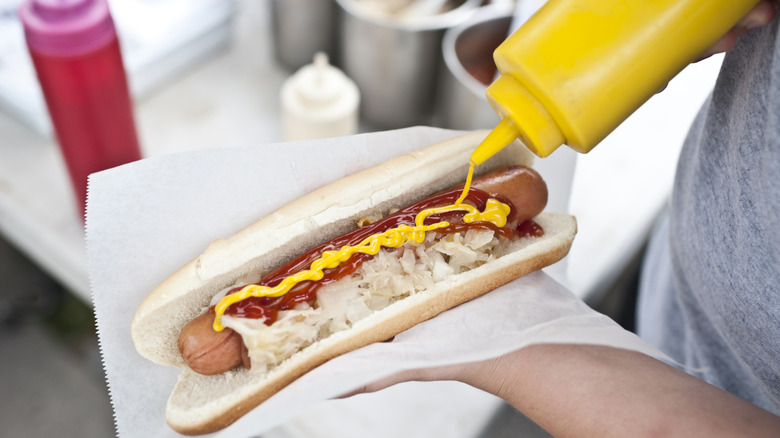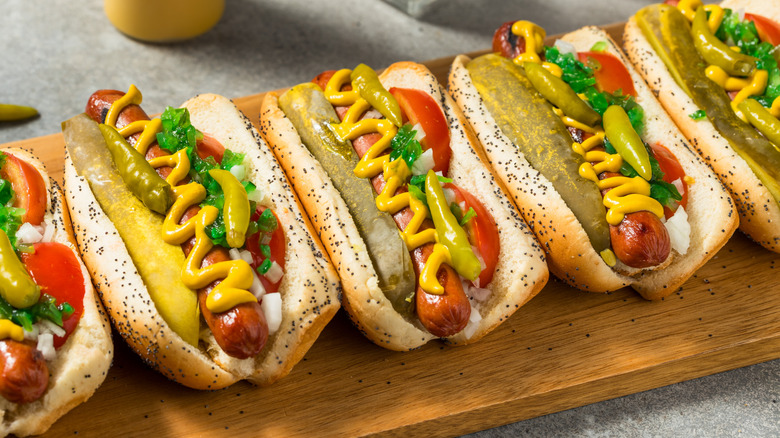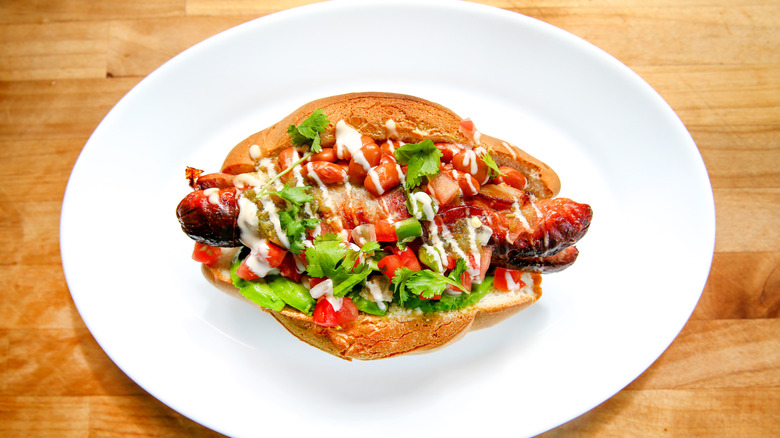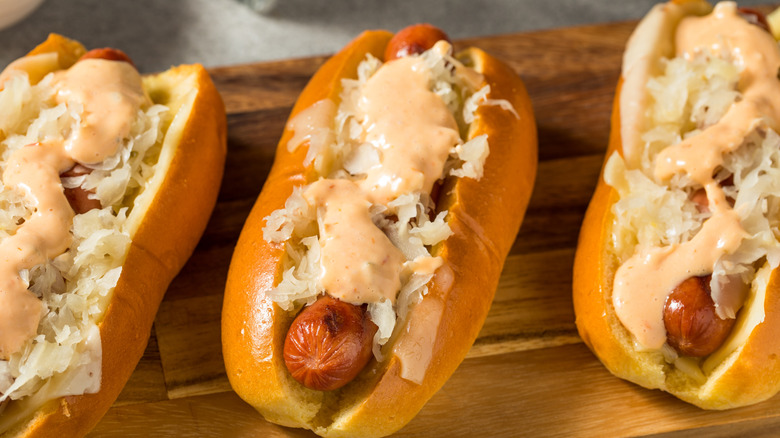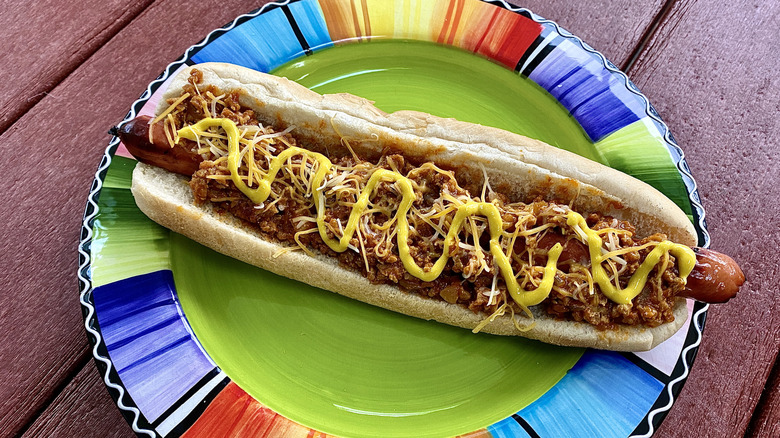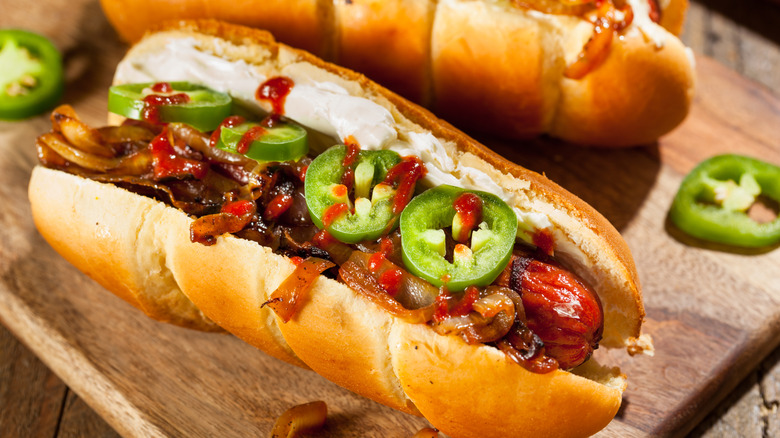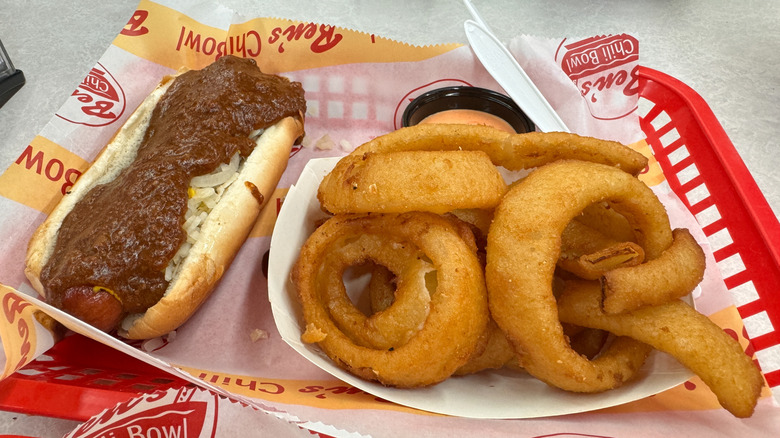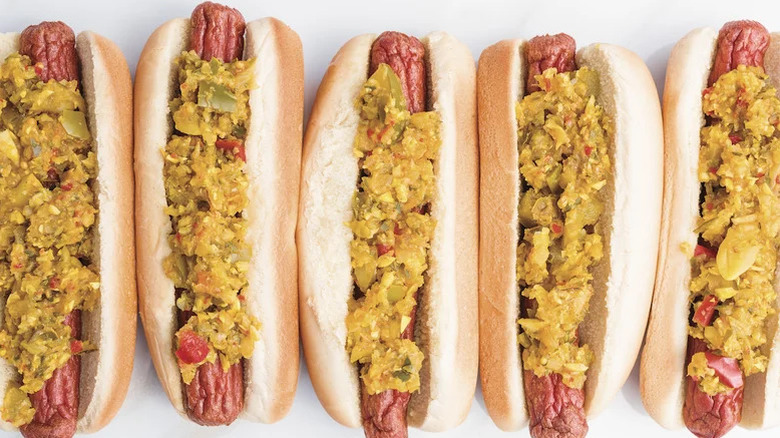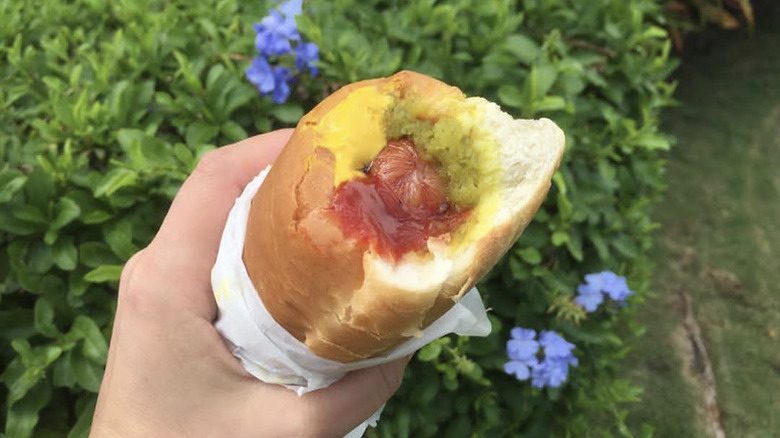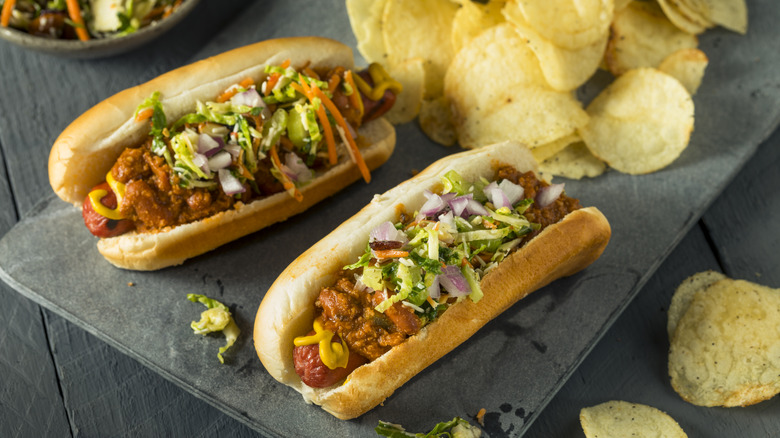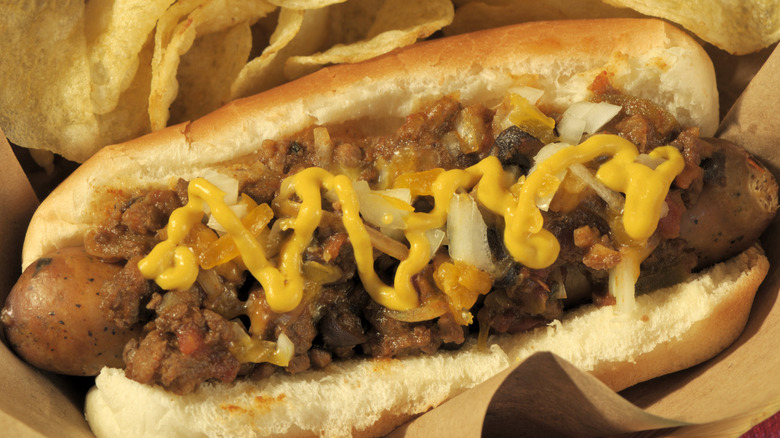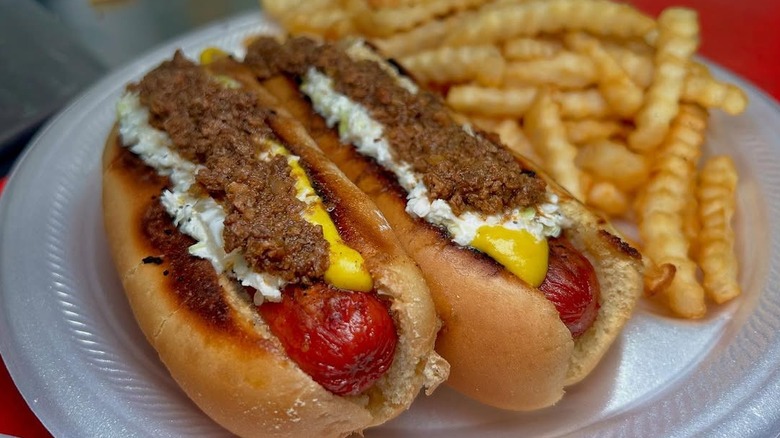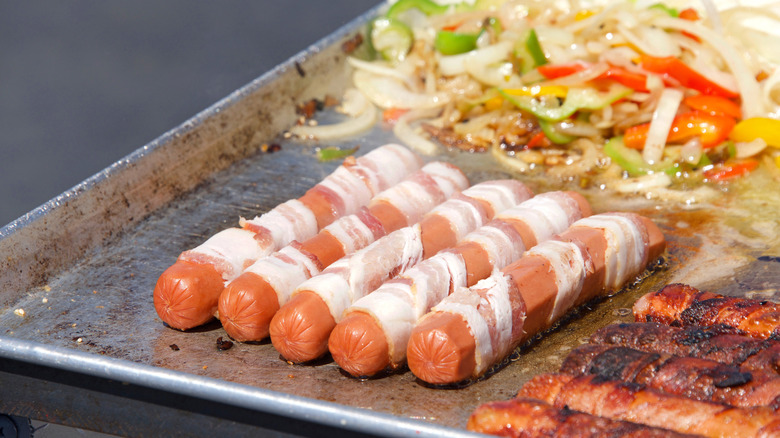14 Regional Hot Dogs You Should Try On Your Next US Road Trip
Is there anything more quintessentially American than a hot dog? The ballpark favorite, the not-a-sandwich, not-a-taco is a unique creation all its own. Grilled, boiled, steamed, smoked, or roasted, there are plenty of ways to cook a hot dog. Beloved at backyard BBQs, state fairs, and warm weather picnics, a hot dog can be as simple or as complex as you want it to be. Stripe it red and yellow with ketchup and mustard, or load it up with chili, cheese, hot peppers, and onions. Depending on who you're talking to, there's no wrong way to dress a hot dog.
If you're looking to take a road trip as the summer comes rolling in, might we suggest making the humble hot dog the inspiration for the journey? Across the country, the regional styles of this beloved lunchtime staple differ, from the meat used to preferred buns to condiment selections. (If you're in Chicago, you won't want to be caught dead dousing your hot dog in ketchup.) So, saddle up and read on to determine which creative culinary hot spot for hot dogs you'll have to add to your itinerary.
New York dog - New York City
Walk down pretty much any street in New York City, and you'll see a hot dog cart with their iconic blue-and-yellow umbrella. In the Big Apple, the hot dog of choice is a classic, all-beef kosher hot dog with a natural casing. These dogs are boiled rather than grilled or steamed, and any leftover dogs are kept in warm-water baths to season them and prevent them from drying out. This also gives them the not-so-appetizing nickname of "dirty water dog." (Don't worry, the water isn't actually dirty –– it's seasoned with items like vinegar, garlic powder, chili flakes, and onion powder, although the actual mix may vary from vendor to vendor.)
The traditional topping for a New York-style hot dog is mustard and sauerkraut, but other condiments are available, like ketchup and sweet steamed onions. Iconic NYC brands like Katz' Delicatessen, Gray's Papaya, Papaya King, and Sabrett are some of the ones to look out for when you want to grab a bite of the beloved "dirty" dog.
Chicago dog - Chicago, Illinois
If you're looking for a hot dog that goes hard on toppings, you'll want to order a Chicago dog. A dog that's ordered "with the works" or "dragged through the garden," the all-beef kosher hot dog is boiled or steamed and served on a poppyseed bun with yellow mustard, bright green relish, chopped onions, tomato slices, hot sport peppers, a pickle spear, and a dash of celery salt. (The iconic hue of that neon-green relish is achieved with food coloring; it's still the same classic relish taste.) The one popular condiment that absolutely does not belong on a Chicago-style hot dog? Ketchup.
The hot dog was first introduced at the World Expo in 1893 by two Austrian-Hungarian immigrants and then grew in popularity during the Great Depression when the dogs were sold from street carts for a nickel. While they're definitely a little more pricey these days, for the amount of toppings you get, we still say they're worth it.
Sonoran hot dog - Arizona
Blending Mexican cuisine into an American classic, the Sonoran dog gets its name from its place of origin, in the Mexican state of Sonora. Popular in Arizona –– specifically Tuscon and Phoenix –– this style sees a hot dog get wrapped in bacon and grilled before being stuffed into a large Mexican dinner roll known as a bolillo. It's then topped with pinto beans, grilled onions, green peppers, chopped tomatoes, tomatillo jalapeño salsa, mayonnaise or crema, mustard, and shredded cheese. (This style can also use other popular regional condiments like cotija cheese, quesa fresca, whole chiles, and guacamole.)
This hot dog hasn't been around quite as long as the previous two, having originated in the 1980s, but it has been embraced as part of Southwestern cuisine ever since. The next time you're looking to grab a bite of Tex-Mex cuisine, perhaps leave the fajitas and burritos for another time and give the Sonoran hot dog a try instead.
Kansas City-style hot dog - Kansas and Missouri
While the hot dogs on this list so far have been of the all-beef variety, the Kansas City-style hot dog departs from the usual by featuring a pork sausage instead. The bun of this hot dog is also not the normal standard steamed bun, either. Like the Chicago dog, the Kansas City hot dog uses a bun with seeds –– sesame seeds in this case. Finally, the classic toppings for this style of hot dog are melted Swiss cheese, brown mustard, and sauerkraut.
You might notice something different in this picture: That isn't in the usual lineup of Kansas City-style hot dog toppings. The drizzle on this dog is none other than Thousand Island dressing. The creamy, ketchup-and-mayo hybrid salad dressing is vital when upgrading the Kansas City-style hot dog into the Reuben hot dog. That and the caraway seeds, of course. You certainly won't want to kiss anyone after chowing down on this dog!
Coney Island hot dog - New York and Michigan
The food cart stand's dirty water dog isn't the only hot dog that was first made famous in New York. Although Michigan –– particularly Detroit –– has claimed the Coney Island hot dog as its own, it first originated on New York's Coney Island, where an immigrant named Nathan Handwerker sold them from his stand in the late 1910s. As you might have guessed, this hardworking Nathan later became the person behind "Nathan's," a brand of kosher hot dogs as well as a fast-food chain.
What sets the Coney Island hot dog apart from others is all about the toppings. While some of these hot dogs are sold in a short bun, others are longer. Whatever the base, the toppings remain the same: a bean-less chili (basically a seasoned meat sauce), chopped white onions, yellow mustard, and –– frequently used but not required –– a pile of finely shredded cheddar cheese.
Seattle dog - Washington
Leave it to the West Coast to get seriously creative when it comes to their hot dog toppings selections, especially the cheese. The Seattle-style hot dog (or Seattle dog) is a favored choice among attendees to outdoor concerts or ball games, usually purchased from nearby food carts. This hot dog originated in the late 1980s with a food vendor who operated a bagel cart –– which might explain why the most famous topping on a Seattle dog is the cream cheese. Who doesn't love a bagel with a little schmear? (Looking for a bagel shop road trip? We've got you.)
A grilled hot dog is placed in a toasted bun with a generous helping of cream cheese smeared alongside it. Optional toppings include grilled onions, fresh jalapeños, and Sriracha sauce, but it's the cream cheese that makes this hot dog an icon. In 2019, a gourmet version from chef Renee Erickson was created that featured whipped cream cheese, pickled red onions, pickled jalapeños, and salmon roe caviar.
The Half-Smoke - Washington, D.C.
Half-beef, half-pork, and all delicious, this dog also gets the double treatment when it comes to preparation, too, since it's both smoked and grilled. The origin of the name is somewhat murky, with a few explanations for it. One version is that the "half" comes from the half-pork, half-beef mixture, while the smoke is the way it's cooked. However, half-smokes can also be all beef, and it can be steamed instead of smoked. Another theory is that the texture and snappiness of the hot dog taste sort of like a smoked sausage and sort of like a regular hot dog.
A third guess as to the name is that the sausage is cut in half before grilling. Whatever the etymology of this particular hot dog, the flavor of smoke –– either natural or artificial –– and the coarse grind of the meat are what distinguishes it.
Like the Coney Island dog, the half-smoke is also topped with chili, mustard, and chopped onions. Cheese is optional, but everything tastes better with it anyway, so we'd load it on and dig in.
Ripper hot dog - New Jersey
Grilled, boiled, steamed, smoked ... and deep-fried? That's what makes the New Jersey Ripper dog unique. Unlike every other regional hot dog style on this list, this version from the Garden State gets wrapped in bacon and deep-fried until the skin begins to wrinkle, burst, and, well, rip.
The natural casing of the New Jersey Ripper dog is what allows the hot oil to split it, switching up the tender meaty inside into something crispier.
This style of hot dog was said to have been first created by a restaurant called Rutt's Hut, which first operated as a roadside stand in 1928 and still exists as a must-try tourist destination today. This is where Rippers became famous. Top it with the proprietary yellow relish made of cabbage, carrots, mustard, and a secret blend of spices. Also at Rutt's, customers have the option of how long their dog takes a dunk: in-and-out; a "weller," which is a well-done dog; and a "cremator," where the dog is fried until it gets black spots.
Hawaiian-style dog - Hawaii
Some hot dogs stand out for their bun, their toppings, or their method of cooking. Hawaiian-style hot dogs are probably the most unusual for their bun. Rather than a standard hot dog bun or even a split-top bun, this style uses a Hawaiian sweet bun that has a hole punched through it. This is achieved by using a heated-up poker to pierce the bun, creating space for the hot dog sausage and toasting the inside simultaneously.
Also known as a "puka dog," the meat of this hot dog is a Polish sausage. While you could choose the standard ketchup and mustard to top this hot dog, why not incorporate some of the flavors of the islands instead? Popular toppings include a lemon garlic sauce, banana relish, passionfruit mustard, mango relish, and guava mustard. These unique condiments are rarely found elsewhere and are a deliciously unexpected choice when trying the puka dog. The result is sweet, salty, spicy, and savory.
Atlanta-style hot dog - Georgia
Looking for something cool, crisp, and crunchy to cut through the salty meatiness of your hot dog? The Atlanta-style hot dog may just be what you're looking for. This style of hot dog is popular in Georgia, but you won't be finding peaches in this dish (even if the stone fruit does taste incredible on the grill). Instead, this style of hot dog is a riff on the chili dog.
A hot dog gets placed in a bun and piled with chili but, instead of the usual mustard, cheese, or onions like in the Coney Island dog, it gets a refreshing burst from creamy coleslaw. The blend of crisp cabbage, tender carrots, and snappy onions helps to balance the other salty, meaty ingredients. Coming from a Southern state where the temperatures can reach sweltering levels, it makes perfect sense to us that its citizens would want a hot dog topping that doesn't leave them mopping their brows.
The Norfolk dog - Virginia
There shouldn't be any confusion as to how this style of hot dog earned its name: The Norfolk hot dog hails from Norfolk, Virginia. First appearing in the 1930s, the Norfolk dog was the creation of a man named George Bacalis, who began selling the natural-casing hot dog in downtown Norfolk. While the weiner itself wasn't anything special, what earned it the name was the way it was prepared.
The long, skinny hot dogs originally came from Hormel and had a signature snap to them, leaving plenty of room for the all-important toppings. The hot dog was placed on a steamed bun and served with a bean-free chili or meat sauce, fresh-cut onions, and Lynnhaven-brand mustard. Like the Norfolk dog, Lynnhaven mustard was also a Virginia institution, frequently popping up on hot dog stands as a standard deli-style mustard. While there aren't any bells and whistles to this gastronomic creation, it's much beloved by the locals in the region.
Cheese Coneys - Cincinnati, Ohio
You'd be forgiven if you thought that Coney Island hot dogs and cheese coneys were one in the same, but while the former has made a home for itself on the East Coast, the latter originated in the Midwest.
These hot dogs are smaller in size — the bun as well as the dog. Cheese coneys are all-beef franks served in steamed buns and topped with Cincinnati-style chili. Also known as "skyline chili," Cincinnati-style chili uses spices like cinnamon, clove, and allspice to flavor it –– spices that we usually reserve for desserts and baked goods. The recipe came from a pair of Greek brothers who were using the Mediterranean spices they were familiar with to develop a meat sauce. While it's usually served over spaghetti, the cheese coney has it served on the hot dogs. Cheese coneys also often have mustard and chopped onions, as well as a veritable mountain of shredded cheddar cheese piled on top.
Carolina-style hot dog - North Carolina
Recognizable on sight thanks to their distinct red color, Carolina-style hot dogs (or "Carolina red hots") are actually artificially colored so that they stand out from their hot dog brethren. There are plenty of hot dogs in North Carolina stores that boast the brilliant hue, with names like "red hots" and "red links." However, many of the dyes used in certain brands will actually be banned by 2027, so if you want a taste of the traditional red hot, you'll have to pack your bags and make the trip soon. If you can't get your hands on an actual red hot dog, however, have no fear: you can still dress up the standard dog to match this regional delicacy.
This type of hot dog is prepared Carolina-style, which means it's topped with chili, chopped onions, and coleslaw. The result is meaty, hearty, creamy, and cooling, with a variety of textures and flavors in every bite. Sometimes, mustard will be used instead of the coleslaw, or in addition to it.
LA street dog - Los Angeles
Another hot dog inspired by the Mexican cuisine that proliferates throughout LA's culinary scene is the LA street dog. Sold through street vendors and food carts (hence the name), these bacon-wrapped hot dogs are placed in a bun and topped with plenty of familiar toppings, plus those with a regional twist. Think: grilled onions, jalapeño peppers, and grilled bell peppers alongside mustard, ketchup, and mayonnaise.
Los Angeles vendors tapped into the after-hours crowd's craving for late-night munchies and began setting up outside of bars and nightclubs to dispense their wares. (Some bars themselves also offer LA street dogs on their own menus.) However, the legality of these hot dog stands and carts is questionable, as it's not clear who's operating with or without a license. This has led to some Angelenos dubbing the late-night treat "danger dogs" or "heart attack dogs." From what we've heard about their deliciousness, though, they're worth the risk.

